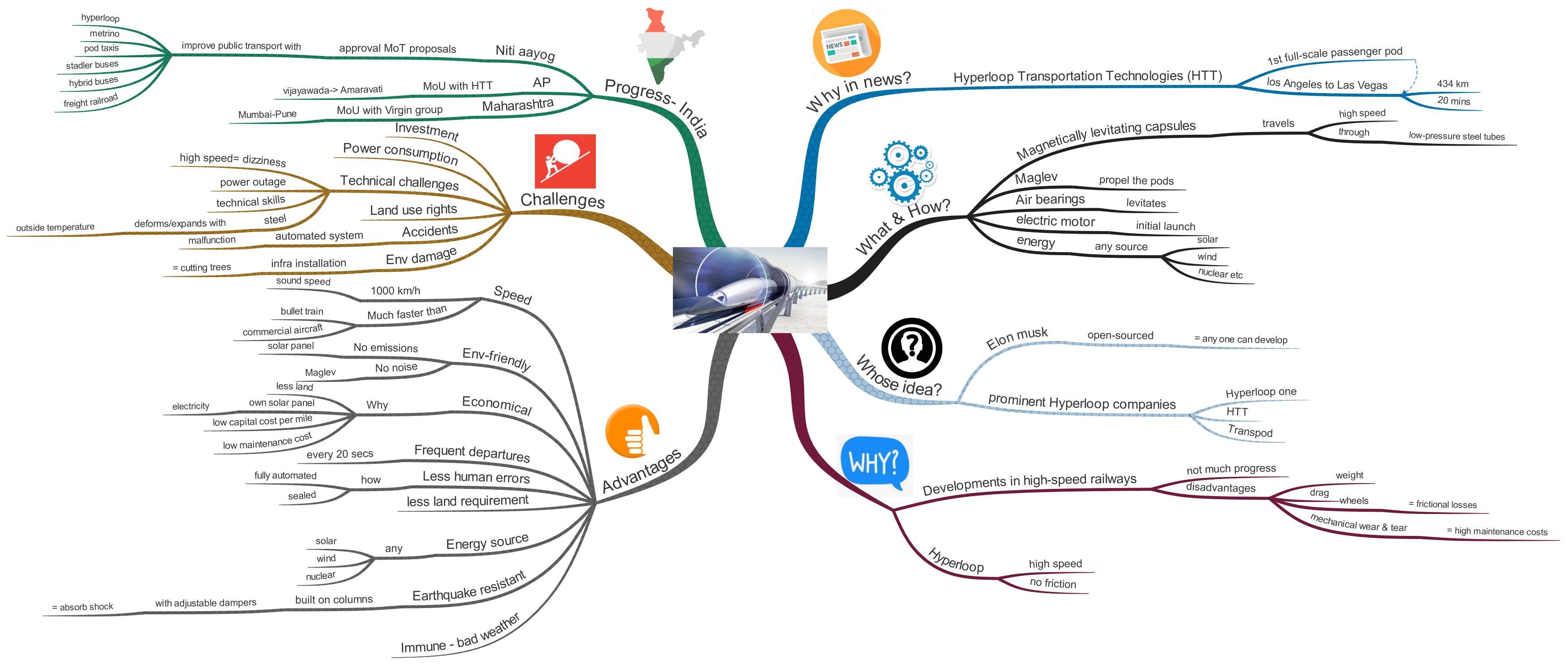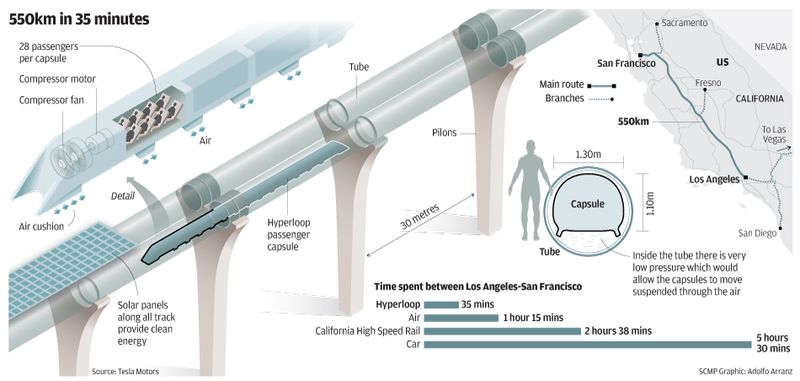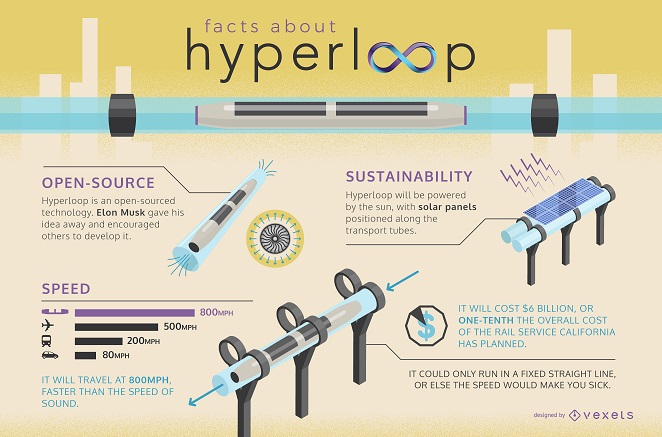Hyperloop – The Future of Transportation

From Current Affairs Notes for UPSC » Editorials & In-depths » This topic
IAS EXPRESS Vs UPSC Prelims 2024: 80+ questions reflected
Recently, Hyperloop Transportation Technologies (HTT) unveiled its first full-scale passenger capsule. It will travel from Los Angeles to Las Vegas (434 km) in just 20 minutes. In this article, we will discuss what, why, when and how of Hyperloop technology and its implementation status in India.
What is Hyperloop and how it works?
- It is a system of magnetically levitating capsules (pods) that travels at high speeds through low-pressure steel tubes without any friction.
- The principle of magnetic levitation (Maglev) is used to propel the pods inside the tubes and the air bearings are implemented to levitate the pods.
- The pod would initially be launched with an electric motor before magnetic levitation takes place and the pod can glide at cruising speed in the low—pressure environment.
- It can draw energy from any source including solar panels, windmills or even nuclear reactors.
- It is still in trial stages in various countries and not been implemented for practical use anywhere in the world yet.
Whose idea was Hyperloop?
- Hyperloop is the brainchild idea of SpaceX and Tesla CEO, Elon Musk who dubs it as the fifth mode of transportation.
- The Hyperloop technology has been completely open-sourced by Musk so that others can take the ideas and further develop them.
- Hyperloop One, Hyperloop Transportation Technologies, and Transpod are some of the prominent companies that are working on hyperloop projects around the world.
Also read: Reusuable Launch Vehicle – The Road to Cheap Space Travel
Why hyperloop?
- Developments in conventional high-speed railway technology have not made much progress in recent years.
- From steam to diesel to electric, locomotives have disadvantages of weight and drag.
- Frictional losses also come into play when a locomotive relies on wheels.
- When speeds accelerate, mechanical wear and tear result in high maintenance costs.
- In hyperloop, magnetic levitation and air bearings improve speed and remove the problem of friction.
- An increasing interest in hyperloop can also be explained by several other advantages as follows.
What are the advantages of Hyperloop Technology?
Speed: Due to the sealed environment which causes little or no friction, hyperloop can reach a speed up to 1000 km/h which is 2 to 3 times faster than the bullet train and even commercial aircraft.
Environment-friendly: Compared to railways, it has smaller civil engineering footprint, with no direct emissions or noise as it uses solar panels to generate electricity and maglev creates no noise.
Economical: Hyperloop needs relatively less ground to cover and it uses its own solar panels to generate electricity. Hyperloop’s capital cost per mile is 60% of high-speed rail and also less expensive to operate. Due to this, the fare can be much cheaper compared to aircraft or bullet trains.
Frequent departures: Hyperloop departures could happen with a low frequency of every 20 seconds which is impossible in railways.
Less prone to human errors: because the system is fully automated and sealed.
Less land requirement: because steel tubes can be either built on a column or tunnelled underground.
Energy source: Hyperloop can draw energy from any source such as solar panels, windmills and even nuclear reactors.
Resistant to earthquakes: because the Hyperloop would be built on columns with two adjustable lateral dampers, so the tube would not be rigidly fixed to the ground. This would allow it to absorb the force of movement and not be shattered by it.
Immune to bad weather conditions.
What are the challenges in implementing Hyperloop?
Investment: It needs heavy investment and hence effective coordination between public and private sector is required for implementing it.
Power consumption: It consumes the high amount of electricity compared to railways.
Technical challenges:
- The high speed of capsule at the speed of sound may cause dizziness to the passengers because of vibration and jostling and they are subject to excessive gravitational forces during turns. In order to avoid this, the Hyperloop has to travel in a straight line. It should not really make turns, and when it does, the turns have to be very gradual.
- Hyperloop is highly susceptible to disruption from a power outage.
- The long vacuum chamber manufacturing needs more technical skills.
- As hyperloop uses steel for the track, it expands and changes shape when outside temperature is changed. This may destroy the track of hyperloop technology. This needs to be considered while designing the systems based on the environment of the location.
Land use rights: will also be the concern for the implementation of the project.
Accidents: It has the very high risk to life when some malfunction happens to the automated system.
Environmental damage: The installation of infrastructure needs cutting of a large number of trees. This will result in environmental damage.
What is the status of hyperloop in India? (Timeline)
- In July 2017, NITI (National Institution for Transforming India) Aayog has approved 6 proposals of the Ministry of Transport for improving public transport through high-tech mass rapid transportation techs such as hyperloop, metrino, pod taxis, Stadler buses, hybrid buses and freight railroad.
- In September 2017, Andhra Pradesh signed a Memorandum of Understanding (MoU) with Hyperloop Transportation Technologies (HIT) for developing the project. The proposed Hyperloop will cover 35 km distance between Vijayawada and Amaravati within 5 minutes.
- In February 2018. Maharashtra signed an agreement with Virgin group to build a Hyperloop connecting Mumbai and Pune reducing travel time from 3 hours to just 25 minutes.
Also read: Artificial Leaf: The Next big thing in the fight against Climate Change
Way ahead
With rising global warming and climate change, Hyperloop provides scope for an environmental-friendly transportation with very high speed. However, the technical and other challenges needs to be addressed for effective implementation of the project.
Practice Question
- What is the science and technology behind the concept of hyperloop? Examine whether it can transform how Indians travel?
If you like this post, please share your feedback in the comments section below so that we will upload more posts like this.





